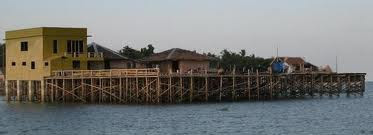HINGOTANAN ISLAND
THE HEART OF THE ISLANDERS:HINGOTANAN
Hingotanan is one of the islands in Bien Unido Bohol. It may not be beautiful as other places have showed, but it's unique in its way as it captures the eye of the islanders. It has something that people from other places could appreciate.

Hingotanan is one of the coral islands dotting the north eastern coastline of Bohol in Central Visayas. It is one of the bigger islands and the most densely populated. In the late 1970's ,due to it's swelling population going over 5,000 of aboit 700 households, a move to split yhe barangay into two was initiated by the late Mr. Apronianio Paden who was then a sitting municipal councilor of Bien Unido ,the island's mother town.
Eventually, the sincere efforts of those who were behind it paid off and a decision was reached. Hingotanan was officially divided into two separate barangays which are known as Hingotanan East and Hingotanan West.
The total land area of the entire island is only 32.7 hectares. The means of transportation to go in and out of the islands in between it's neighboring barangays and coastal towns of Bohol ,Leyte and Cebu are called pumpboats.
The island is compose of four sitios namely: 1) Lugating on the West , 2) Tunga on the North, 3)Lawis on the West and 4) Luyo at the South. It's inhabitants are predominatly Roman Catholics and very few are affiliated with either the Baptist or the Protestants of the United Church of Christ congregations.
The early 1980's were the pivotal years and dawn of a miraculous economic taransformation amongst the people of this island, when its naturally abundant marine product SEAWEED existed.
Seaweed farming is a booming $7-billion global industry presently shared by 15
countries in the world. About 15 million metric tons were harvested in
2007 from these countries, nearly double the total of a decade earlier,
according to U.N.'s Food and Agriculture Organization. China is the
largest producer and exporter and nearly all its crop is farmed in
operations that fill entire bays and estuaries.
THE LIVELIHOOD OF PEOPLE
''SEAWEEDS FARMING''

Seaweed is a primitive sea plant belonging to the algae family with origins dating back millions of years. It comes in four popular varieties (scientifically known as: cottonii, agar-agar, spinosum and eucheuma). It is an important food in many Asian cultures. Japanese cuisine employs different varieties (such as kombu, laver and nori) for many uses including soups, vegetables, tea, sushi and as general seasoning. It is also a rich source of iodine, an important nutrient. Many seaweeds also provide alginic acid, a jellylike substance that's used as a stabilizer and thickener in a wide variety of commercially processed foods such as ice creams, puddings, flavored milk drinks, pie fillings, soups and syrups.
This seaweed phenomenon has dramatically elevated their lives economically in total contrast with what they used to do and have in fishing. Every able family member of any household in the community are either directly or indirectly involved in the overall cycle in the cultivation of the product, of course with monetary considerations as to labour being invested from its preparation prior to planting, to harvesting and drying for final delivery to the buyers. Consequently, the limited earning capacity of the people on fishing had been satisfactorily augmented and practically made easy and tenable by the advent of this industry.

Hingotanan and Dawahon share about 35% of the country's total production. The most common variety being cultivated here are Cottonii (Kappaphycus alvarezii) and Spinosum (eucheuma denticulatum) which together provide about three quarters of the world production. They grow at sea level down to about 2 metres. Seaweed is normally grown on nylon lines strung between bamboo floats and harvested after three months or so when each plant weighs around 1 kilogram. The shallow waters along the Dawahon Reef was found to be perfectly suitable in the cultivation and farming of this marine plant commercially.
After harvest, the seaweed is dried, baled and sent to the carrageenan manufacturer. There the seaweed is ground, sifted to remove impurities such as sand and washed thoroughly. After treatment with hot alkali solution (e.g. 5-8% potassium hydroxide), the cellulose is removed from the carrageenan by centrifugation and filtration. The resulting carrageenan solution is then concentrated by evaporation. It is dried and ground to specifications.
On top of these God given bounties, the island is also blessed with intellectual abundance in reference to its numerous professionals who are mostly successful in their individual fields of endeavor locally and abroad. Some are in high places in the government, numerous managers in different private companies and many are successful private practitioners in the field of law, medicine, engineering and entrepreneurship.
Drying of Seaweeds
Drying of Seaweeds

Harvesting Seaweeds
Platforms (where seaweeds are dried)
Platforms are small warehouses that are build in seas where seaweeds are dried and stocked. People mostly ,build their own for their survival and others are for the sucess of business purposes.
A VIDEO(How this occupation helps people)
It is also a rich source of iodine, an important nutrient. Many seaweeds also provide alginic acid, a jellylike substance that's used as a stabilizer and thickener in a wide variety of commercially processed foods such as ice creams, puddings, flavored milk drinks, pie fillings, soups and syrups.
THE FEAST CELEBRATION
Of all the islands in Bien Unido, Hingotanan alone celebrates the feast of the entire place through a Fluvial Parade which is done in every month of June. It is a great experience indeed and people really don't miss the enjoyment that they could gain from the procession. All the residents are encouraged to join the parade and enjoy the sea experience right after.
 |
HINGOTANIAN FOODS
There are lots of foods in this particular island that is well known to other places ad even displayed in some famous restaurants.
TUNA BELLY
KINILAW OR RAW FISH SALAD
PRAWNS


























